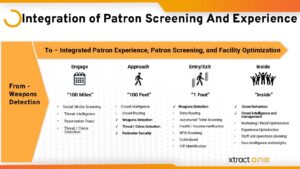As “soft targets” go, sports stadiums provide a particularly complex challenge to security professionals. They cater to tens of thousands of people at a time, have multiple points of entry and egress, large external areas where people congregate, and, of course, an interior where those thousands of people are packed together watching a game or concert.
Whether it’s a sports franchise or a concert promoter, the success of a stadium-based business relies on the ability to deliver a consistently good patron experience, which can be compromised by security incidents and the disruptions caused by security processes. And, if new security processes aren’t thought out and tested properly, they might solve one risk but create others. For example, metal detectors and pat downs might keep weapons out of the stadium, but they also create lines of people outside of the stadium, which can be an inviting target to terrorists and others seeking to cause mayhem. (Unfortunately, this scenario is not just conjecture − it has played out in actual stadium attacks, the bombings outside of Manchester Arena in England and the Stade de France in Paris being two of the most notable.)
The convergence of September 11-driven safety concerns for large-scale attacks, with the rise of social media and the proliferation of guns, has changed the stadium security game. The days of focusing almost exclusively on alcohol consumption and unruly fans are gone. Now security pros also have to protect against external threats and the issues that can arise around patrons carrying weapons.
All of this requires a new approach that takes into account security on the inside, at the gateway, outside and online. Fundamentally, there needs to be a new “security fabric” that can extend across all of these areas and adapt to an evolving threat landscape, while simultaneously preserving or enhancing the patron experience.

AI Weaves the Fabric
These new security requirements can’t be met with traditional manual approaches. Technology must be intelligently deployed to augment the existing security team and processes, and in some cases may require the development and refinement of new processes.
The common “thread” running across the security fabric is artificial intelligence (AI). AI can automate many of the new security requirements and inform security strategy and operations, while also reducing the overall impact of security processes on the patron experience. Some examples of how this is being done today include:
- Using AI-based patron scanning to detect weapons accurately and without requiring the delays caused by walk-through metal detectors. (Imagine a world where only those carrying weapons need to empty their pockets.)
- AI-enabled video can deliver a broad range of capabilities and benefits. From a security standpoint, it can identify weapons outside and inside the stadium, as well as disturbances, abandoned packages and other anomalous issues of concern. From an operational standpoint, it can alert management when lines are forming at concession stands, identify spills and trash that require attention, etc.
- There are also AI applications that can gather online intelligence that can feed security strategy and operations. For example, if a group is planning a disturbance at the stadium, or if individuals are making threats on social media, AI can identify and alert on these postings so security managers can take appropriate pre-emptive actions before the event occurs. Patron screening and patron security is not solely limited to the gate and entry. Just like cybersecurity, where advancements in insights and the correlation of those through AI can provide pre-emptive security, and enhanced user experiences changing the dynamic of the service (please edit this idea). Many large-scale attacks are planned online – for example, in 2018 ISIS was calling for “lone wolf” attacks against the various venues in Russia hosting World Cup soccer. Russian authorities hardened those targets and there were no successful attacks.
AI is not a “silver bullet” for securing stadiums. However, it can be a powerful tool augmenting existing security capabilities, and uniting security operations under a single fabric. And, as we all know, a fabric is made up of individual threads, woven together to create a coherent whole. For modern stadium security requirements, AI can be the threads that tie together security strategy with tactical execution and operations, to deliver the patron experience everyone hopes to have, and the secure experience everyone needs.
